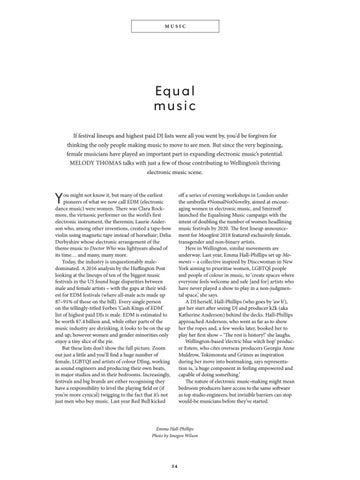MUSIC
Eq u a l music If festival lineups and highest paid DJ lists were all you went by, you'd be forgiven for thinking the only people making music to move to are men. But since the very beginning, female musicians have played an important part in expanding electronic music’s potential. MELODY THOMAS talks with just a few of those contributing to Wellington’s thriving electronic music scene.
Y
ou might not know it, but many of the earliest pioneers of what we now call EDM (electronic dance music) were women. There was Clara Rockmore, the virtuosic performer on the world’s first electronic instrument, the theremin; Laurie Anderson who, among other inventions, created a tape-bow violin using magnetic tape instead of horsehair; Delia Derbyshire whose electronic arrangement of the theme music to Doctor Who was lightyears ahead of its time… and many, many more. Today, the industry is unquestionably maledominated. A 2016 analysis by the Huffington Post looking at the lineups of ten of the biggest music festivals in the US found huge disparities between male and female artists – with the gaps at their widest for EDM festivals (where all-male acts made up 87–91% of those on the bill). Every single person on the tellingly-titled Forbes ‘Cash Kings of EDM’ list of highest paid DJs is male. EDM is estimated to be worth $7.4 billion and, while other parts of the music industry are shrinking, it looks to be on the up and up; however women and gender minorities only enjoy a tiny slice of the pie. But these lists don’t show the full picture. Zoom out just a little and you’ll find a huge number of female, LGBTQI and artists of colour DJing, working as sound engineers and producing their own beats, in major studios and in their bedrooms. Increasingly, festivals and big brands are either recognising they have a responsibility to level the playing field or (if you’re more cynical) twigging to the fact that it’s not just men who buy music. Last year Red Bull kicked
off a series of evening workshops in London under the umbrella #NomalNotNovelty, aimed at encouraging women in electronic music, and Smirnoff launched the Equalising Music campaign with the intent of doubling the number of women headlining music festivals by 2020. The first lineup announcement for Moogfest 2018 featured exclusively female, transgender and non-binary artists. Here in Wellington, similar movements are underway. Last year, Emma Hall-Phillips set up Moments − a collective inspired by Disccwoman in New York aiming to prioritise women, LGBTQI people and people of colour in music, to ‘create spaces where everyone feels welcome and safe [and for] artists who have never played a show to play in a non-judgmental space,’ she says. A DJ herself, Hall-Phillips (who goes by ‘aw b’), got her start after seeing DJ and producer k2k (aka Katherine Anderson) behind the decks. Hall-Phillips approached Anderson, who went as far as to show her the ropes and, a few weeks later, booked her to play her first show – ‘The rest is history!’ she laughs. Wellington-based ‘electric blue witch hop’ producer Estere, who cites overseas producers Georgia Anne Muldrow, Tokimonsta and Grimes as inspiration during her move into beatmaking, says representation is, ‘a huge component in feeling empowered and capable of doing something.’ The nature of electronic music-making might mean bedroom producers have access to the same software as top studio engineers, but invisible barriers can stop would-be musicians before they’ve started.
Emma Hall-Phillips Photo by Imogen Wilson
34
